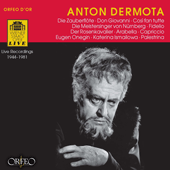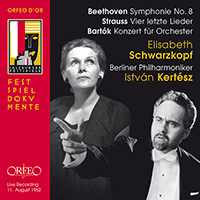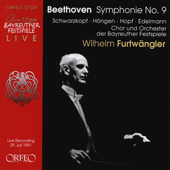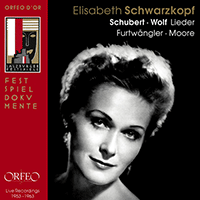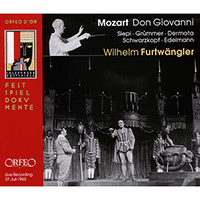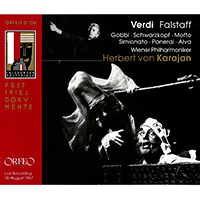Elisabeth Schwarzkopf
The daughter of highly-educated Prussians, Schwarzkopf was unable to enter university because her father, a headmaster who taught Classics, had refused to allow a Nazi meeting at his school in 1933 and was banned from teaching. Instead she turned to music, having undertaken her first operatic role, Eurydice in Gluck’s Orfeo, while still a schoolgirl. In 1934 she enrolled at the Berlin High School for Music where she became a pupil of Lula Mysz-Gmeiner, who trained her as a mezzo-soprano. On the advice of the baritone Karl Schmitt-Walter she changed teachers, becoming a pupil of Maria Ivogün, the distinguished coloratura soprano, whose husband was the pianist Michael Raucheisen. She made her formal operatic debut in May 1938 as a Flower Maiden / Parsifal at the Berlin Städtische Oper (later Deutsche Oper), considered second in quality to the Berlin State Opera.
Her first roles at the Städtische Oper were minor, but she also sang the title role in Verdi’s Alzira for Berlin radio (1938), appeared in five films produced by UFA (from 1939) and recorded operetta excerpts for Telefunken with the tenor Rupert Glawitsch (1940). After singing Musetta / La Bohème at the Städtische Oper in 1939, from 1940 Schwarzkopf began to secure more significant roles such as Adele / Die Fledermaus and Zerbinetta / Ariadne auf Naxos. She graduated to Susanna / Le nozze di Figaro in 1942, the year in which she was heard by Karl Böhm, who invited her to give some guest performances with the Vienna State Opera.
She made her debut in Vienna during late 1942 as Zerbinetta, receiving favourable reviews, and then sang Blonde in a new production of Die Entführung aus dem Serail conducted by Böhm. On New Year’s Eve 1942, Schwarzkopf gave what was to be her final performance at the Städtische Oper (as Adele) and then returned to Vienna to sing Musetta and Rosina / Il barbiere di Siviglia. After some concerts in Berlin however, she entered a clinic in the Tatra Mountains suffering from a chest complaint, remaining on sick leave until early 1944. She eventually returned to Vienna, fully recovered, and in an Austrian radio broadcast of summer 1944 moved up to the role of Konstanze in Entführung. Having fled to Salzburg prior to the occupation of Vienna by the Russians in 1945, she later returned to Vienna and the State Opera company, singing Nedda / Pagliacci and Mimì / La Bohème.
While still a student, Schwarzkopf had joined the Nazi Student League, volunteering to become a student leader; and while with the Städtische Oper in the late 1930s applied to join the Nazi Party. Membership was granted to her in 1940, the year in which she also joined the National Socialist People’s Welfare organisation. After the end of World War II, despite attempts at investigation into her Nazi past, Schwarzkopf continued to sing with the Vienna State Opera in major roles, including Violetta / La traviata and Gilda / Rigoletto.
In late 1946 she met Walter Legge, who gave her an exclusive contract with EMI’s Columbia label (alongside Herbert von Karajan). Legge, whom Schwarzkopf married in 1953, was to re-form her career, with an intense focus upon an increasingly limited number of roles and upon lieder. During the autumn of 1947 she sang Donna Elvira / Don Giovanni and Marzelline / Fidelio with the Vienna State Opera on its visit to London. Here she was well received by critics and audiences, and at the same time was becoming better-known through her recordings. She joined the young Covent Garden Opera Company with effect from the beginning of 1948, singing Pamina / Die Zauberflöte in English, while also singing in Vienna. Her London roles included Mimì, Violetta and Gilda as well
as Sophie / Der Rosenkavalier, Butterfly / Madama Butterfly and Eva / Die Meistersinger von Nürnberg, which she was to sing at the reopening of the Bayreuth Festival in 1951, with Karajan conducting.
By now Schwarzkopf was on the threshold of a truly international career, one which was to be divided between selected operatic appearances and lieder recitals. She had made her debut at La Scala, Milan at the end of 1950 (as Elisabeth / Tannhäuser with Karajan conducting) and subsequently sang her first Marschallin / Der Rosenkavalier there in 1952, again with Karajan at the helm, followed by Elsa / Lohengrin and Mélisande / Pelléas et Mélisande in 1953, and the Countess / Le nozze di Figaro and Marguerite / Faust in 1954. She sang her first Fiordiligi / Così fan tutte at the Piccola Scala, with Cantelli conducting, in 1956.
Schwarzkopf’s operatic appearances were by now principally focused upon Donna Elvira, the Countess, Fiordiligi, the Marschallin and Alice Ford / Falstaff, with occasional excursions into other roles. She sang regularly, if not every year, at the Salzburg Festival from 1947 until 1964, the year in which she made her debut at the Metropolitan Opera as the Marschallin. She returned for a single Donna Elvira in 1966. In addition she sang regularly with the San Francisco Opera, having made her debut there as the Marschallin in 1955. A notable late role was the Countess / Capriccio which she sang on stage for the first time in Vienna in 1960, with Böhm conducting.
As the 1960s progressed Schwarzkopf reduced her operatic appearances and concentrated upon giving recitals. She made her formal farewell to the operatic stage in Brussels at the end of December 1971, with the first act of Der Rosenkavalier, and gave her final song recital in Zürich in 1979. She continued to be active giving master-classes.
If any singer deserved the frequently used operatic epithet ‘sacred monster’ it was Schwarzkopf. Always extremely well prepared, her performances possessed a glacial perfection that either attracted or repelled. Under Legge’s relentless tuition her voice became perfectly suited to the few roles which she sang from the mid-1950s onwards, although his detailed and continuing guidance inevitably resulted in many of her interpretations possessing a highly studied character. On stage she had undeniable presence and in the concert hall she maintained her regal poise. Her close relationship with Legge ensured a vast volume of recordings for the Columbia label, most of which attained an extremely high standard both musically and technically. She was especially stylish in the performance of operetta, as well as in her favoured operatic war-horses.
© Naxos Rights International Ltd. — David Patmore (A–Z of Singers, Naxos 8.558097-100).








